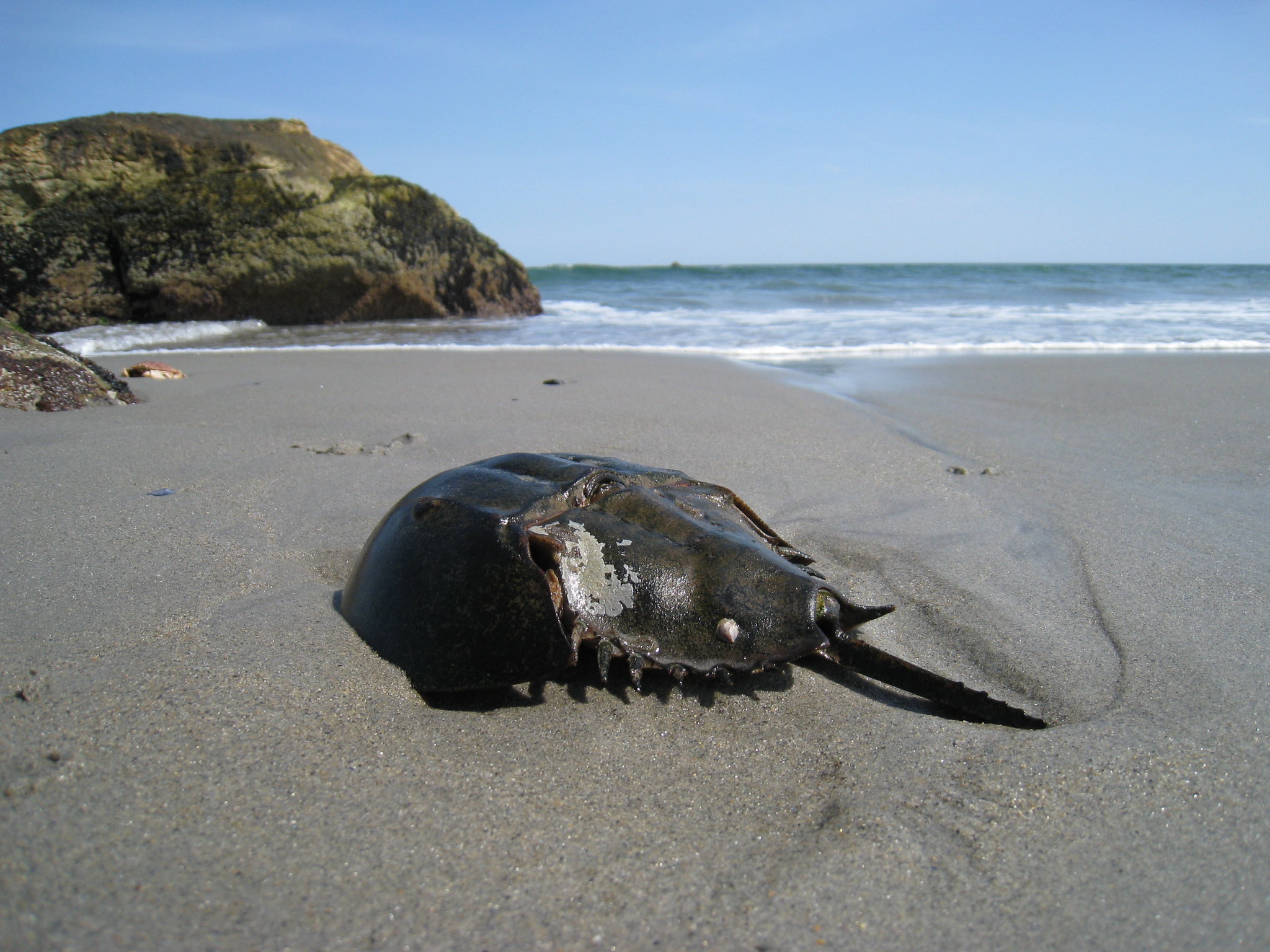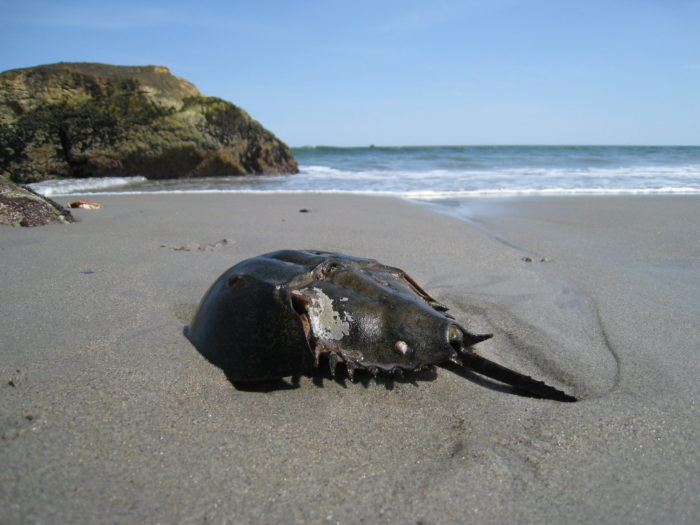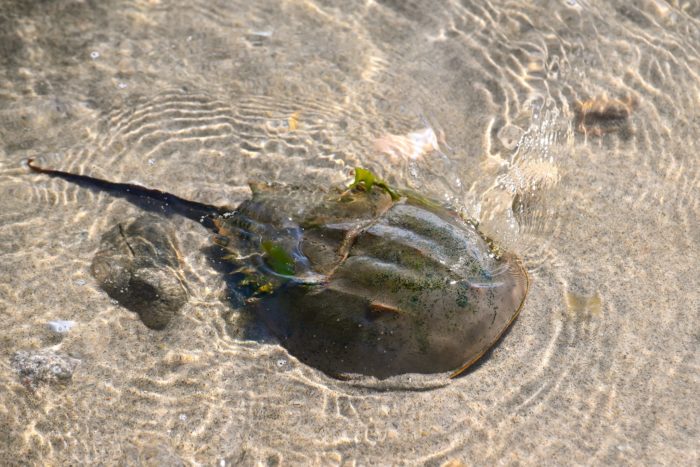
Sea Wonder: Horseshoe Crab

Photo credit: Helen Zhang
Named for its rounded and u-shaped head, the horseshoe crab found in the United States (Limulus polyphemus) is just one of four species of horseshoe crabs that call the ocean and coasts home. These incredible shelled marvels are relics from a prehistoric time, looking and behaving pretty much the same as they did 445 million years ago! You read that right, horseshoe crabs are living fossils that predate and have outlived dinosaurs.
Description
Horseshoe crabs are not really crabs at all – they are invertebrates that are more closely related to spiders, scorpions, and ticks. Attached to the top side of their bodies are hard shells or exoskeletons, which they shed and replace multiple times throughout their life cycles. Their tapered exoskeletons are brown-green in color with several symmetrical series of bumps and ridges, and at the end of their bodies are a spike-like tail and on their undersides are five pairs of jointed legs. They have gills behind their legs that resemble the folds of a book and have 10 eyes and several other photoreceptors located throughout the body; their largest pair of eyes are near the head. When fully grown, horseshoe crabs can reach lengths of two feet and weigh up to 10 pounds. They swim upside down and can survive on land for several days if their gills stay moist.
Diet & Habitat
Horseshoe crabs usually feed on smaller invertebrates like clams, crustaceans, and worms; on occasion they will feed on algae and smaller fish. To feed, they will crush hard-shelled food with their legs before passing it along to the mouth located at the front of their bodies. Similar to birds, horseshoe crabs have muscles called gizzards that they use to grind food before it passes into their stomachs.
In the United States, horseshoe crabs live along the Atlantic coast with a range spanning from Maine down to the Florida peninsula and around into coastal Alabama and Mississippi. In the National Marine Sanctuary System, horseshoe crabs live in or near Stellwagen Bank, Gray’s Reef, and Florida Keys national marine sanctuaries. The largest spawning population of horseshoe crabs in the world are located in Delaware Bay.
Adults are benthic animals that live in offshore habitats near the continental shelf and in shallow estuarine areas, making them a common sight for beachgoers and the introduction of many children to marine wildlife. In the winter months, adults either remain in estuarine areas or migrate to the continental shelf, and in the later parts of spring they move to beaches to spawn. Sometimes, waves or other interferences flip horseshoe crabs upside down, but they can use their tails to create momentum that they use to turn themselves right.
Life History
Horseshoe crabs live in much the same way as they have for hundreds of millions of years. They spawn in the spring and summer, events that peak in May and June. Spawning occurs during evening high tides during full or new moons and involves adults aggregating onto sandy beaches that are protected by dunes and other natural features where they fertilize and lay their eggs in moist sand. Adults return to their estuarine or offshore waters after breeding season ends.
Horseshoe crab eggs are ecologically important to migrating shorebirds that feed on them. Eggs incubate for about a month before those that haven’t been eaten hatch. Horseshoe crab hatchlings look like miniaturized versions of adults and move to shallow, sandy nursery areas where they stay for up to two years, growing and molting frequently in their juvenile years. When nearly full grown, horseshoe crabs leave their nurseries and make their way to estuary bays or offshore waters where they can live long lives. They reach sexual maturity at between nine and 12 years of age and may live another 10 years or more after that.
Threats & Conservation
Horseshoe crab populations in the United States have fluctuated over time with a noticeable decrease in 1998 and an increase in recent years. They are ecologically important animals with their eggs serving as a major source of food for shorebirds, including the threatened red knot. Some shorebird species have even adapted and evolved over time to have their migrations coincide with peak horseshoe crab spawning activity. Horseshoe crabs also provide bait for commercial American eel and conch fisheries along the eastern seaboard, and are caught using trawls, hand harvests, and dredging methods. Horseshoe crab blood is also important to the biomedical industry as it contains a blood-clotting agent known as limulus amoebocyte lysate (LAL), which the FDA requires to test all injectable and intravenous drugs produced in the United States. The majority of horseshoe crab harvests come from the Delaware Bay region, followed by New York, New England, and the Southeast.
Fisheries managers are responsible for balancing the many natural and social uses of horseshoe crabs, which creates an interesting case study in marine resource management along the Atlantic coast. Threats facing the horseshoe crab populations beyond direct targeting and overexploitation include bycatch, physical and chemical pollution, coastal development, environmental changes like warming waters and ocean acidification.

Photo credit: Larry Lamsa
